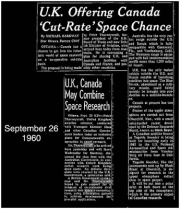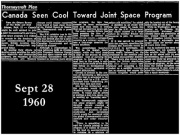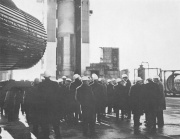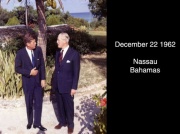The Empire Strikes Out - Canada's Defence & The Commonwealth Space Program - Part 7 by Robert Godwin
From The Space Library
Contents |
Canada Rejects the Commonwealth Space Program
On September 26th 1960 The British Aviation Minister, Peter Thorneycroft, arrived in Ottawa to solicit Canada's support.[1] The Diefenbaker government reversed their position of a year earlier and made it known that they were not interested in participating in a Commonwealth space program.[2] With the Bomarc issue still hanging in the air Canada's government expressed little interest in telling the Canadian public that they might be considering financing yet another missile program, regardless of what it was for; especially since they had already committed to Black Brant. This was clearly the moment when the plans for a Commonwealth space program died. The dream had lasted barely two years.
In some respects this was one of the critical moments when Britain ceased to be the mother of Empire and reluctantly became part of Europe. The choices remaining to Westminster were to concede space to the USA and the Soviet Union, or make a deal with Germany and France.
In early 1961 discussions continued briefly between Canada, Britain, Belgium, Denmark, Germany, Italy, Holland, Norway and Switzerland for a joint Commonwealth/Europe space launcher. Delegates from these countries were taken to see the Blue Streak facilities but the Canadian government, when it was paying any attention to space at all, would continue to look at the bigger opportunity offered by its southern neighbor. Rather than commit to a Commonwealth/ European space program Canada's government chose to sit on the sidelines with observer status. A formal agreement was undertaken by the UK, France and the United States to investigate the benefits of trans-Atlantic satellite communications. Canada was to be kept "fully informed" of their progress. The already scheduled Canadian Alouette satellite would, once launched, perhaps provide some insights into the problems associated with long-range satellite communications.[3]
Now resettled in England James C. Floyd was leading a team at Hawker Siddeley to design a solar powered communications satellite to be launched by Blue Streak or the newly proposed European launcher. The paper his team created, Industry and Space, A Franco-British Study of European Potential, assumed that Britain would cooperate with France to build and launch the project. In July 1961, at the Convention of the British Institution of Radio Engineers, Geoffrey Pardoe demonstrated the revolutionary new STEM antenna, built by De Havilland in Canada and now slated for launch on the Canadian top-sounding satellite. Pardoe worked tirelessly for the next two years to persuade the British government of the importance of satellites for communications.
Diefenbaker Looks For Support
In January 1962 Diefenbaker's special assistant sent a memo to his Under-Secretary of State for External Affairs. This memo gives some insight into the posture of the Canadian Cabinet and particularly the Prime Minister, who was evidently still casting about for examples of other countries that had made expensive cancellations.
"To illustrate the dilemma, the Prime Minister would like to have available factual information which would enable him to show that other governments have in the past several years found themselves obliged to abandon major weapons programmes, to embark on fresh allocations of their resources, and to tolerate the financial implications of such decisions. The examples which the Prime Minister gave are the Blue Streak programme in the United Kingdom and, on a smaller scale, the recent British decision not to proceed with the offer of bombs for Canberra aircraft in the Congo.
"The Prime Minister said that he had seen reports of equally relevant and more substantial cancellations and adjustments affecting the United States. He thought he recalled an article in the Christian Science Monitor, analyzing the weapons programmes which had had to be abandoned or cut back at enormous cost to the United States Treasury. The foregoing information should, I think, be prepared in a memorandum, double spaced, in a form which the Prime Minister could readily adapt for use in the House."[4]
While concentrating on strengthening his political position at home the Prime Minister seemed to be missing the big picture.
Britain Pursues the Big Stick
Things were scarcely any better for Harold MacMillan. The Skybolt was cancelled, almost exactly as the Daily Express had predicted - within two years. Since the British government had never allowed Avro to upgrade it, the Mark 1 version of Blue Steel ended up being deployed that year and stayed in service until 1969. It had been assumed that the Douglas Skybolt would make any improvements to the British missile unnecessary.
MacMillan and President Kennedy held an emergency meeting in Nassau Bahamas in December 1962 to resolve the pressing issue of Britain’s nuclear force. Diefenbaker's advisors told him that they held little hope that MacMillan would get any compromise from Kennedy, who had just successfully navigated the Cuban Missile Crisis without any assistance from Britain.[5]
MacMillan’s own party was insistent that Britain continue to have its own nuclear deterrent. To his credit MacMillan informed Kennedy that if the U.S. were to cancel Skybolt without providing a suitable British-controlled alternative, then Britain would have to build their own. MacMillan suggested to Kennedy that he would settle for the sea-launched, highly mobile, and considerably more expensive Polaris missile. The first Polaris launch from a U.S. submarine had taken place in the summer of 1960. The American nuclear fleet was now on-station around the world and had unquestionably been the USA's "big stick" during the Cuban Missile Crisis.
Kennedy was not prepared for MacMillan's request and postponed his meeting with Diefenbaker while he brought in advisors from Washington.[6] Reluctantly Kennedy and his cabinet chose to supply Polaris to the UK at a bargain price and leave it under British control. It was, in the eyes of Robert McNamara, the U.S. Secretary of Defense, the lesser of two evils, but it was an option that Canada could not, and would not have considered for a multitude of reasons. On the last day of the summit Diefenbaker arrived in Nassau and discussed NATO, the nuclear deterrent and trade with MacMillan. Diefenbaker later reported that MacMillan looked like "the cat that had swallowed the canary" when discussing Polaris.[7]
However, Diefenbaker's conversation with Kennedy seems to have been brief; after discussing Canada's role with Cuba and wheat sales to China he expressed his desire to keep nuclear weapons out of Canada; effectively making the Bomarc useless. Kennedy then turned the conversation to the Apollo program and explained lunar orbit rendezvous to Diefenbaker.
Diefenbaker later stated, "The difference between Prime Minister MacMillan's position and my own was that if the United States acted in such a way as to cause MacMillan's defeat, they would almost certainly bring to power in Britain a government much less sympathetic to United States economic and political objectives."
Go to Chapter
Footnotes
- ^ Toronto Star Sept 26 1960
- ^ Globe and Mail Sep 28 1960
- ^ Globe and Mail May 27 1961
- ^ Memorandum from Special Assistant to Prime Minister to Under-Secretary of State for External Affairs Jan 10 1962
- ^ Memorandum from United States Division to Assistant Under-Secretary of State for External Affairs Dec 13 1962
- ^ Memorandum by Assistant Under-Secretary of State for External Affairs Jan 3 1963
- ^ Memorandum from Deputy Under-Secretary of State for External Affairs to Special Assistant to Prime Minister Dec 27 1962





